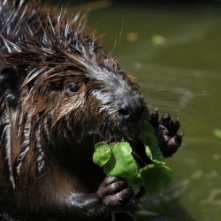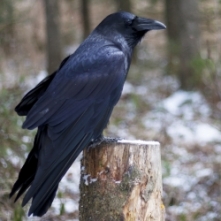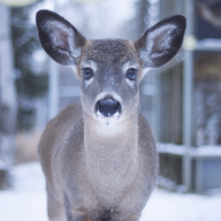The popular belief is that a bird of prey is a bird that hunts and eats meat for food. However, birds belonging to other families also hunt and eat meat (the kingfisher is one example).

The coyote is a canine, like the wolf or the domestic dog, whose weight averages between 9 & 23kgs, compared to the grey wolf which averages between 20 & 70kgs the coyote is considerably smaller.

The claws on its front paws are particularly developed to permit the marmot to dig. It prefers open, well drained terrain to dig its burrow. This generally contains a main entrance & one or more observation holes.

Moose are very expensive to keep in captivity. At the Refuge Pageau, the moose arrive as young orphans and remain for the duration of their life due to their close contact with humans.

Passerine birds are the largest group of birds as they contain the largest number of species. Each species has its own cry or song. They have 4 toes on each foot, 3 on the front & 1 on the rear allowing it to perch.

It usually weighs between 2.5 and 4 kg. In winter, their coat is very dense and white or pale gray blue . Their coat becomes thinner in the spring and summer and darkens into shades of brown or gray.

When its wings are deployed , it has a wingspan of up to 2.45 meters and weighs on average 4.3 kg. As with the majority of birds of prey, the female is often larger and heavier than the male.

The average weight of a female black bear is 70kg and a male black bear is 135kg but exceptionally have observed up to 290kgs. Perhaps you have had the occasion to view one of these exceptions at the Refuge Pageau.

Its front paws resemble hands whilst the rear paws are webbed. They are not very able or speedy on terra firma but very graceful and comfortable once in water!

Contrary to the cougar the lynx has a short tail. Long legs & large paws enable the Lynx to walk easily on the snow. Around their ears grows protruding tufts of hair. As with all felines, the Lynx is a carnivore.

Their bad reputation warranted their extermination in many regions in North America. However, going back in history it is rare to find cases where a wolf has attacked a human.

The Porcupine is essentially a nocturnal animal. It slows down during winter but does not hibernate unlike the marmot for example.

Wooded areas near rivers are its preferred habitat, but they are very adaptable to urban and residential areas. Small aquatic animals, small mammals, eggs, fruits, nuts, etc. are just as some of the foods consumed by raccoons.

Several things can help differentiate the raven & the crow starting with size. The raven is the largest of the two has an average wingspan of 118 cm, compared to the American crow whose average size is 90 cm.

The red fox is a small canine that weighs between 3.6 and 6.8 kg, the male being slightly larger than the female. The red fox is one of the most common mammals in Canada. It is found in all provinces and territories.

The river otter is a carnivorous species rather common, though unobtrusive. It feeds mostly underwater & mainly on fish but also on shellfish, crayfish, frogs, insects, small mammals and turtles.

The snowy owl symbolises the whiteness of the Quebec winters, a bird who is established in our semi-nordic climate, its territory extends over vast distances from the arctic tundra of the extreme north of Canada to the north o

Like most animals, the skunk prefers to retreat rather than approach a larger predator. Skunks do not spray as readily as one would think. In fact they give several warnings by scrapping & taping its front paws.

Despite being larger than the Roe Deer, the White Tailed Deer is the smallest of the deer species (Cervidae) in North America, with its weight varying between 50 kg & 136kg.
